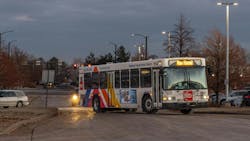Denver RTD highlights 2024 safety efforts in annual safety metrics report
The Denver Regional Transit District (RTD) reported several year-over-year improvements and incident decreases in the agency’s annual safety metrics. In 2024, the agency reported improvements in the number of light-rail events, a decrease in commuter rail trespassers, a slight improvement in the overall number of on-the-job injuries and adopted a Vision Zero resolution.
The agency says it met all of its established bus and light-rail targets related to minimizing fatalities across the system. Denver RTD credits enhancements that were made in 2024 to establish a proactive safety framework, such as the Welton Street Safety Improvements project, which added new train-related roadway signs and upgraded train warning traffic signals to better warn motorists of trains approaching the intersections. Other 2024 agency safety improvements included increased employee trainings, bolstered internal and external safety communications and strategies implemented for hazard mitigation.
“Safety is paramount and is inherent in all [Denver] RTD does,” said Denver RTD General Manager and CEO Debra A. Johnson. “The agency’s commitment to operational safety ensures [Denver] RTD employees are provided an optimal work environment, and customers can confidently use mobility services to reach their destination. The metrics not only highlight year-over-year improvements and successes but allow [Denver] RTD staff to note areas that require additional enhancements and mitigation strategies.”
The agency says light rail’s preventable accident rate per 100,000 miles of revenue service decreased to 0.08 in 2024. In comparison to 2023, the rate saw a year-over-year drop of 33.3 percent –– exceeding Denver RTD’s target of fewer than one incident per 100,000 miles and marking a significant achievement in rail safety. The agency also utilizes a light-rail simulator to help operators prepare to handle multiple situations they may experience when working in the field. The agency notes all light-rail operators are required to spend time in the simulator as part of its focus on safety and employee training.
On commuter rail, trespasser incidents saw a year-over-year decrease in 2024. Denver RTD notes the Federal Railroad Administration defines a trespasser as any individual who is unlawfully on or near railroad tracks, which includes individuals crossing tracks while warning lights are flashing and bells are sounding, or a person crossing at a non-designated area of the alignment. In 2023, Denver RTD recorded 423 commuter rail trespassers and in 2024 saw that number decrease to 399.
Denver RTD says the decrease is being attributed to an expansion in community outreach efforts and enhanced safety messaging along the corridors. The agency notes the most notable decrease was along the 23-mile A Line, which experienced a reduction of approximately 12 percent in trespasser incidents occurring between Denver Union Station and the Denver Airport Station.
To reduce the number of potential trespassers, Denver RTD partnered with Operation Lifesaver to conduct outreach in communities living near commuter rail corridors. The agency hosted pop-up events at rail stations and employment centers to directly engage with customers and individuals living and working near railroad tracks. A rail safety video and other resource materials were also produced in English and Spanish to support community engagement efforts and the agency’s online safety campaign.
Like all other U.S. mass transit agencies, Denver RTD annually reports thousands of datapoints to the National Transit Database (NTD)’s Safety and Security Module. The annual report includes a detailed breakdown of bus and light-rail collisions, incidents, employee and customer injuries and safety performance metrics based on miles traveled. The agency says it submits the data to comply with federal reporting requirements and to support safety improvement efforts throughout the U.S. and to track trends, develop plans and improve safety for its employees and customers.
In 2024, the Federal Transit Administration updated its reporting requirements for transit worker assaults. Prior to last year’s updated requirement, Denver RTD reported 177 physical assaults and 194 non-physical assaults of its transit workers. In 2024, the agency says physical assaults remained relatively flat at 182 but the number of non-physical assaults increased to 314. Denver RTD notes the approximately 62 percent year-over-year increase in non-physical assaults largely reflects the new federal reporting standards and Denver RTD’s expanded internal efforts to encourage employees to make reports.
“While an increase in reportable events like non-physical assaults may seem negative at first glance, it actually reflects progress made to create a stronger safety culture,” said Denver RTD Deputy CEO Angel Peña. “Employees are reporting more incidents, which indicates the effectiveness of ongoing training, open dialogue and a trust developed between frontline staff and the agency’s safety and operations teams. This culture of transparency is precisely what we aim for, as it allows us to act earlier and prevent incidents from occurring again in the future.”
Denver RTD notes an increased presence of RTD transit police officers is another tactic that is positively impacting employee safety and creating a more welcoming transit environment for customers. In 2024, the agency also added bus operator shield barriers and live look-in cameras on all its buses to enhance safety and reduce the number of physical and non-physical assaults.
Vision Zero
Denver RTD notes the Vision Zero resolution focused on eliminating transit-related fatalities and injuries. To support the resolution and its focus on safety, planning efforts were initiated to create agency-specific strategies. According to the agency, Vision Zero is an internationally recognized, data-driven systems approach to increase personal safety in transportation spaces.
In the year ahead, the agency will continue to collaborate with city planners, community organizations, and local governments to develop and implement Vision Zero strategies and infrastructure improvements beyond the agency’s transit network.
